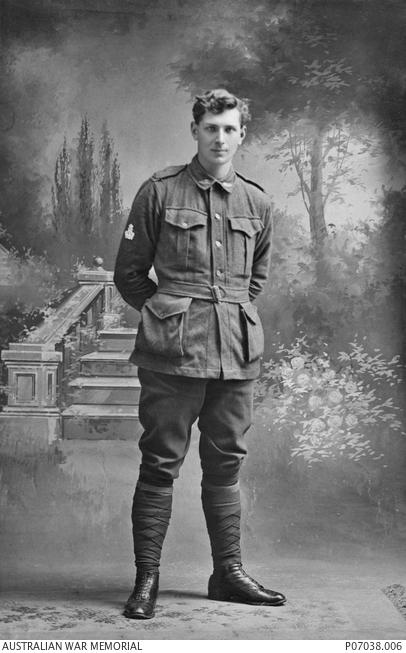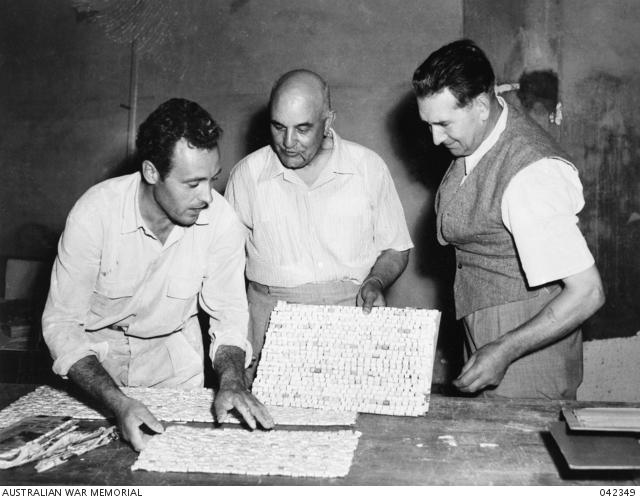‘An artist draws with his head, not his hands’

Studio portrait of Mervyn Napier Waller during the war.
Artist Napier Waller lost his right arm after being wounded in the fighting at Bullecourt in 1917, but he never lost his love of art.
Determined to continue painting and drawing, Waller taught himself to use his left hand, and went on to become a noted Australian muralist, mosaicist and painter, creating the magnificent mosaics and stained glass in the Hall of Memory at the Australian War Memorial.
The Memorial’s Head of Art, Laura Webster, said Waller’s dedication to his art was extraordinary.
“Napier Waller is an important artist to the Memorial,” she said.
“The vast mosaics and stained glass windows he created are extraordinary in their innovation, iconography and overwhelming beauty, and sit within the heart of the Memorial.”
Each year millions of people are moved by his work, which surrounds the Tomb of the Unknown Australian Soldier, but his own life is also a story of courage and determination.
Born Mervyn Napier Waller at Penshurst in country Victoria in June 1893, Waller left school at 14 to work on the family farm before moving to Melbourne in 1913 to study drawing and painting at the National Gallery schools.
He exhibited watercolours and drawings at the Victorian Artists’ Society in 1915, but decided to put his artistic career on hold to serve on the Western Front during the First World War.
He enlisted in the Australian Imperial Force in August 1915 and trained at Royal Park Camp in Victoria before being transferred to the artillery.
He married fellow art student Christian Yandell in October 1915, and in May the following year embarked on the troopship Medic to complete his military training on Salisbury Plain in England.
By the end of 1916, Waller was serving with the 111th Howitzer Battery in France. He used his diary to detail his experiences at the front, complaining of the never-ending cold and mud, and making sketches of the scenes around him.
“Today cold is fearful – beyond words,” he wrote.
“Nearly caught whilst asleep last night: heavy shell fell within yards of trench and threw heaps of dirt upon our tarpaulin cover.
“Travelling is slow and miserable … the drivers must walk for there is ever the danger of being hurt from falling horses. The way is now in deep or steep hills and we pity the horses and then pity ourselves.”
When Waller was severely wounded at Bullecourt in May 1917, his right arm was amputated at the shoulder. During his convalescence in France and England, he trained himself to write and draw with his left hand, later reflecting that “an artist draws with his head, not his hands”.

Napier Waller, right, examining the mosaic with Aldo Rossi with Severino De Marco prior to the first fixing in the Hall of Memory at the Australian War Memorial.
After returning to Australia in November 1917, Waller resumed his work as an artist. He completed a series of images called War sketches in black and white, watercolour and oil which were exhibited in 1918 and 1919 in Melbourne, Sydney, Adelaide, and Hobart.
Over the next two decades, Waller established himself as a mural artist and mosaicist, undertaking large-scale commissions for the Menzies Hotel in Melbourne and the State Library of Victoria.
He visited Europe in the late 1920s to study stained glass, was deeply impressed by the Byzantine mosaics in Ravenna, Italy, and studied mosaic in Venice. When he returned to Melbourne in 1930, he began to work almost exclusively in stained glass and mosaic. He completed a monumental mosaic for the University of Western Australia in 1931, followed by two important commissions in Melbourne: the mosaic façade for Newspaper House, and the murals for the dining hall in the Myer Emporium.
In 1937, the Memorial invited Waller to design and install the stained glass windows and mosaics for the Hall of Memory. The stained glass windows were installed from 1947 to 1950 and Waller worked on the mosaics from 1955 to 1958. During that time, six million tesserae were attached to sheets of paper for the artwork with the help of his art students and war widows in Melbourne, creating one of the largest single mosaics in the world. Despite having only one arm, Waller was actively involved in the entire process.
Today, Napier Waller is also remembered at the Memorial through an art prize named in his honour.
Open to current and former service personnel in the Australian Defence Force, the Napier Waller Art Prize aims to encourage artistic excellence, promote the transformative power of creativity, and raise awareness of the experiences and talent of service personnel.
Research a family member, explore interactive digital experiences, listen to podcasts, and watch videos about the amazing objects that make up the National Collection at the Memorial.
To learn more, visit here.